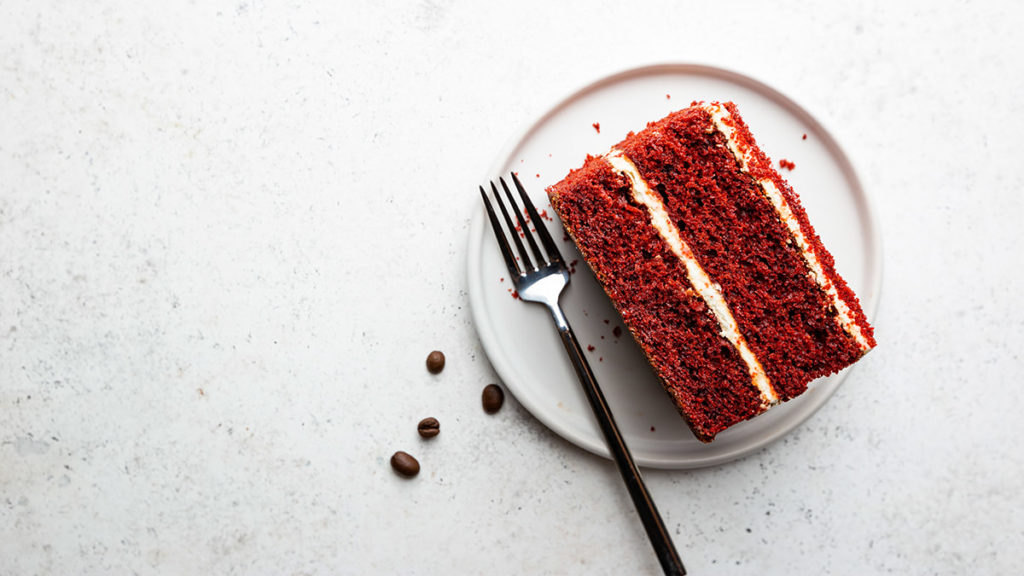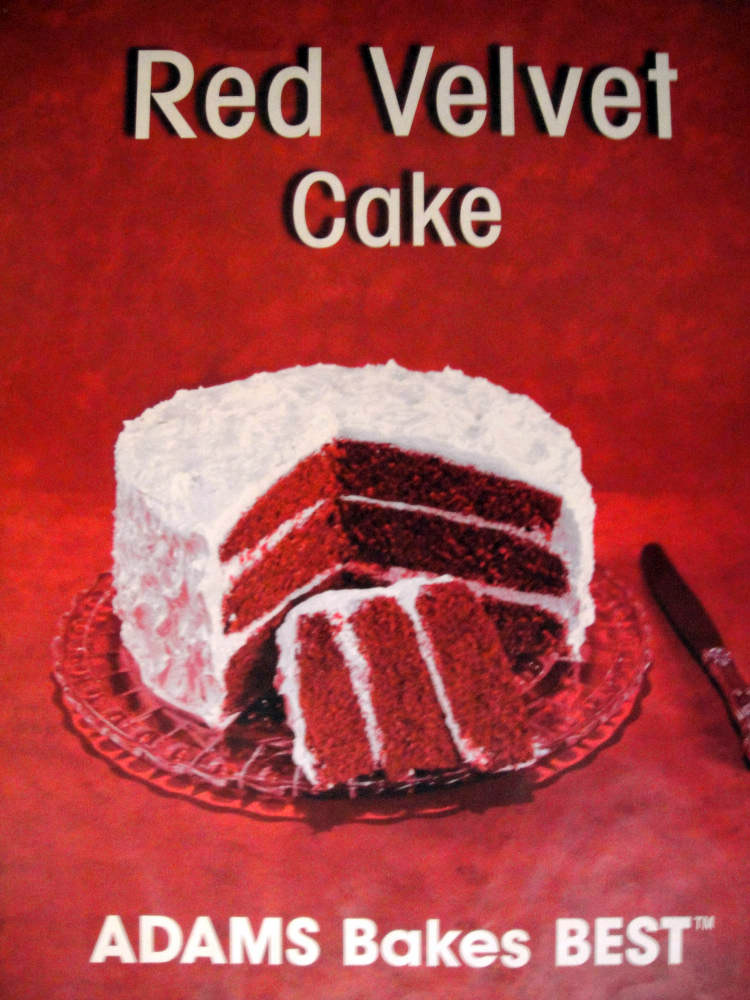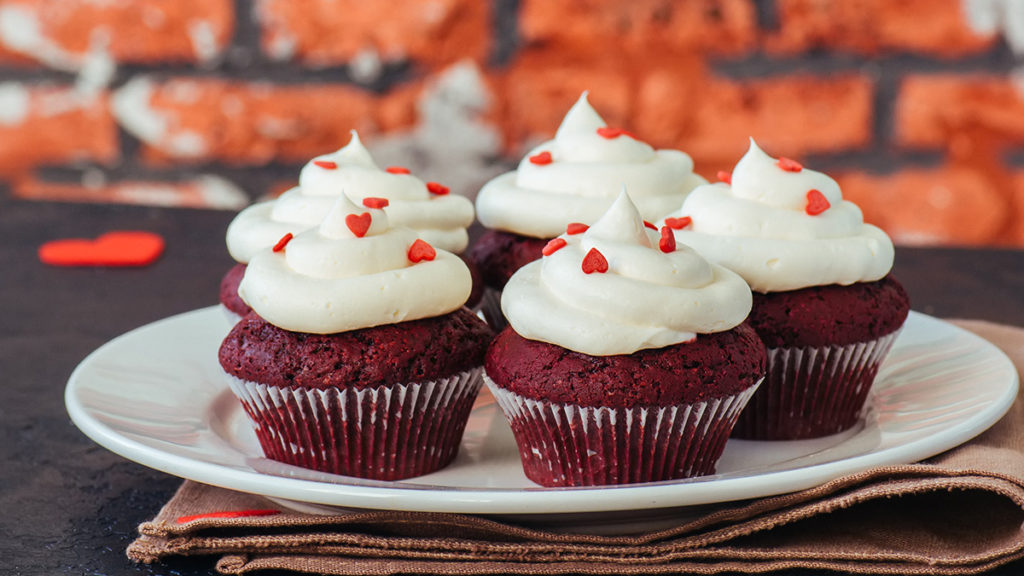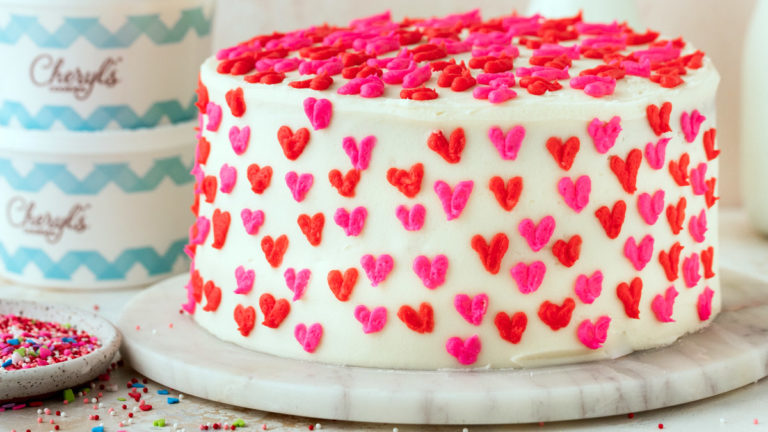Find out fascinating facts and interesting tidbits about cookies and the ingredients found in them in our series “Inside the Dough.” Did it originate in the South? New York? No one is quite sure, which makes the history of red velvet cake all the more fascinating.
Few desserts have a more storied, and contested, history than the luscious red velvet cake. For nearly 100 years and counting, the origins and “official ingredients” of what has become the unofficial confection of Valentine’s Day have remained under serious debate. One thing is certain: What began in the 17th century as a simple cake with an accidental color has become an absolute phenomenon, so loved that its flavor has been reproduced in foods from cookies (and their close cousin, the brookie), popcorn, ice cream, yogurt, and hard candy to — for some reason — fried chicken. Even accessories, such as candles, air fresheners, lip balms, and body lotions, have been given the red velvet treatment. But for all its popularity, questions persist.
Is red velvet cake a Southern classic or New York original? What gives it its rich, crimson color and what type of icing is the “right one”?
It all depends on who you ask.
The birth of a flavor classic
The earliest velvet cakes date back to Victorian times, when bakers in both the United States and England began to use cocoa powder to produce cake of a fine, crumbed texture, one that was much softer than the traditional yellow or white varieties. As the 1900s dawned in America, velvet-style cakes, including mahogany cake and devil’s food cake, became increasingly popular. A blend of the two, called velvet cocoa cake — the most direct relative of our modern red velvet — emerged in 1911.
As bakers continued to increase the amount of unprocessed cocoa in their mixes, they began to inject a brownish-red hue in their final products. This inspired variations of velvet cocoa known as red regal and red feather cake, the recipes for which first appeared in Midwest newspapers during the 1920s.

The reason cocoa causes reddening, and the extent to which it does, remains under debate in the culinary community. Some, such as Bobbie Lloyd, chief baking officer at New York’s legendary Magnolia Bakery, assign this early red tint to a reaction occurring when cocoa powder and buttermilk — both acidic substances — are combined with baking soda. Other bakers, and even some chemists, downplay cocoa’s role, insisting the inclusion of brown sugar (originally called red sugar) in the velvet cocoa cake recipe is what caused the original tint.
Regardless of the source of its color, the version of red in the velvet cocoa cake is nowhere near as vibrant our modern cake’s rich crimson color — which, surprisingly, plays no large role in its flavor.
Further refinement
By the early 1940s, the dark red of velvet cakes had intensified even more. This was rumored to be the result of the addition of beet juice — a popular ingredient in baked goods at the time, due to government food rationing during World War II — to existing velvet recipes. The reddening can also be ascribed to the type of cocoa used in batters of the era. Dutch-processed cocoa, a refined, less bitter version of natural cocoa, became scarce during rationing, leading cooks to utilize other cocoa blends that reddened when mixed with buttermilk.
Recipe tinkering continued, until, in 1943, Irma Rombauer’s classic cookbook The Joy of Cooking introduced America to a dish called red velvet cake. Still, this wasn’t the red velvet we know — some claim that version was under development almost 20 years earlier, in New York City.
Big Apple origins

Manhattan’s Waldorf Astoria, a hotel whose storied kitchen also invented the brunch classic eggs Benedict and namesake Waldorf salad, served one of the earliest “modern” red velvet cakes, if not the first. While the hotel long claims to having served its first version in the mid-1920s, culinary journals including Southern Living report the red velvet cake first appeared at the Waldorf in the mid-1930s — around the same time ritzy Toronto department store Eaton’s starting serving red velvet cake. Eaton’s billed its cake as the creation of socialite Lady Flora Eaton, the wife of wealthy retail heir and royally appointed Canadian knight Sir John Craig Eaton (a claim Southern bakers contest to this day).
In 1940, Texas-based food coloring and extract salesman John A. Adams and his wife, Betty, spent a weekend at the Waldorf, during which they sampled the hotel’s trademark red velvet. That experience inspired the couple to develop their own red velvet cake as a marketing tactic for the Adams Extract brand. In their version, they added a significant amount of their red food coloring, and also replaced butter, which the government was rationing at the time, with butter flavoring and vanilla extract.
Plan in place, the couple packaged these two ingredients with a recipe card and red food coloring, and successfully sold their red velvet cake kit in major grocery stores across the country.
What about that icing?
As if arguments regarding the cake’s creator and color weren’t enough, the type of icing used in a “true” red velvet cake still remains a point of contention. The original Adams cake kit included a recipe for ermine icing, a typical roux-based frosting made with a combination of milk, flour, butter flavoring, and sugar — a much different concoction than the cream cheese frosting that adorns most red velvet cakes today. Many fans of early red velvet cakes, such as the Adams version, prefer ermine to cream cheese, which has become the frosting of choice in newer red velvet recipes mainly because it is easier to make.
Decline and revival

By the early 1970s, red velvet cake had lost its luster among consumers and cooks alike. In his 1972 book American Cookery, legendary American chef James Beard dismissed the dessert as “bland and uninteresting,” and throughout the 1980s, red velvet recipes began to lose their spots in popular cookbooks.
However, after an appearance in the smash 1989 film Steel Magnolias (which features an armadillo-shaped red velvet wedding cake), kitchens throughout the South began to feature the cake. In 2000, storied baker Cake Man Raven brought a perfected Southern recipe to New York, where the city’s Daily News says he “turned a Dixieland dessert into a Brooklyn thing.”
Celebs and the wealthy began to frequent Raven’s, Magnolia Bakery soon developed a version, and, by 2005, upscale bakeries everywhere had made red velvet cake a staple — not to mention one of Valentine’s Day’s most treasured treats.







